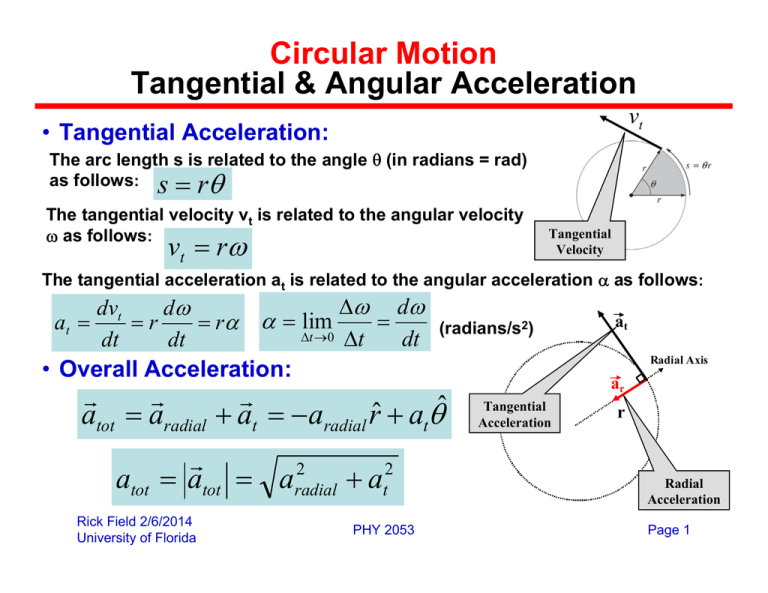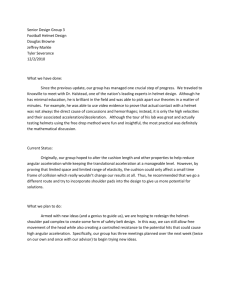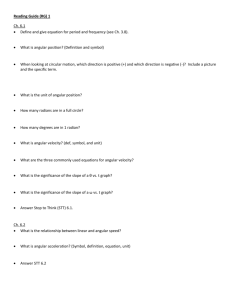Circular Motion & Acceleration: Physics Presentation
advertisement

Circular Motion Tangential & Angular Acceleration vt • Tangential Acceleration: The arc length s is related to the angle θ (in radians = rad) as follows: s = r θ The tangential velocity vt is related to the angular velocity ω as follows: vt = rω Tangential Velocity The tangential acceleration at is related to the angular acceleration α as follows: Δω dω dvt dω v = r ω = at = =r = rα α = lim Δt →0 Δt dt dt dt • Overall Acceleration: t (radians/s2) r r r atot = aradial + at = −aradial rˆ + atθˆ r 2 atot = atot = aradial + at2 Rick Field 2/6/2014 University of Florida PHY 2053 at Radial Axis ar Tangential Acceleration r Radial Acceleration Page 1 Angular Equations of Motion • Angular Equations of Motion (constant α): If the angular acceleration α is constant then α (t ) = α (radians/s2) ω (t ) = ω0 + αt (radians/s) θ (t ) = θ 0 + ω0t + 12 αt 2 (radians) ω 2 (t ) − ω02 = 2α (θ (t ) − θ 0 ) a 2 aradial (t ) = rω (t ) (m/s ) at (t ) = rα (m/s2) vt (t ) = vt 0 + at t (m/s) s (t ) = s0 + vt 0t + at t 1 2 2 (m) v t2 (t ) − vt20 = 2at (s (t ) − s0 ) t aradial (t ) = v t (t ) / r 2 2 Radial Axis (m/s2) ar Tangential Acceleration r Radial Acceleration Rick Field 2/6/2014 University of Florida PHY 2053 Page 2 Angular Equations of Motion • Angular Equations of Motion (constant α): θ (t ) N (t ) = 2π ω (t ) f (t ) = 2π Let N = Number of revolutions (rev) Let f = Number of revolutions per second α (t ) = α α 2π (rad/s2) ω (t ) = ω0 + αt (rad/s) θ (t ) = θ 0 + ω0t + 12 αt 2 (rad) ω 2 (t ) − ω02 = 2α (θ (t ) − θ 0 ) Rick Field 2/6/2014 University of Florida (frequency) (rev/s2) f (t ) = f 0 + ( 2απ )t (rev/s) N (t ) = N 0 + f 0t + ( )t 1 2 α 2π 2 (rev) f 2 (t ) − f 02 = 2( 2απ )( N (t ) − N 0 ) PHY 2053 Page 3 Angular Equations: Examples • A disk rotates about its central axis starting from rest at t = 0 and accelerates with constant angular acceleration. At one time it is rotating at 4 rev/s; 60 revolutions later, its angular speed is 16 rev/s. Starting at t = 0, what is the time required to complete 64 revolutions? f 2 (t ) − f 02 (16rev / s ) 2 − (4rev / s ) 2 α = = 2rev / s 2 = 2π 2( N (t ) − N 0 ) 2(60rev ) N (t ) − N 0 = ( )t 1 2 α 2π 2 t= Answer: t = 8 seconds 2( N (t ) − N 0 ) 2(64rev) = = 8s ( 2απ ) (2rev / s 2 ) • An astronaut is being tested in a centrifuge. The centrifuge has a radius R and, in starting from rest at t = 0, rotates with a constant angular acceleration α = 0.25 rad/s2 . At what time t > 0 is the magnitude of the tangential acceleration equal to the magnitude of the radial acceleration (i.e. centripetal acceleration)? aradial (t ) = Rω 2 (t ) = Rα 2t 2 = at = Rα t= Rick Field 2/6/2014 University of Florida 1 α = Answer: t = 2 seconds 1 = 2s 0.25rad / s 2 PHY 2053 Page 4 Exam 2 Spring 2011: Problem 2 • A race car accelerates uniformly from a speed of 40 m/s to a speed of 58 m/s in 6 seconds while traveling around a circular track of radius 625 m. When the car reaches a speed of 50 m/s what is the magnitude of its total acceleration (in m/s2)? Answer: 5 % Right: 49% Rick Field 2/6/2014 University of Florida v2 − v1 (58m / s ) − (40m / s ) = 3m / s = at = t 2 − t1 6s v 2 (50m / s ) 2 = = 4m / s ar = R 625m atot = at2 + ar2 = 5m / s PHY 2053 Page 5 Gravitation: Circular Orbits (M >> m) For circular orbits the gravitational force is perpendicular to the velocity and hence the speed of the mass m is constant. The force Fg is equal to the mass times the radial (i.e. centripetal) acceleration as follows: GM GmM v2 2 r = (radius of the orbit, constant) Fg = = ma = m = mr ω radial r2 r v2 GM r3 (angular velocity, constant) r r3 2πr T= = 2πr = 2π v GM GM r Fg Assume M >> m so that the position of M is fixed! GM v= (speed, constant) r ω= M For circular orbits r, v, and ω are also constant. (period of rotation) In general both masses rotate about the center-of-mass and the formulas are more complicated! • Kepler’s Third Law: T2 = 4π r GM 2 3 The period squared is proportional to the radius cubed. Rick Field 2/6/2014 University of Florida vm M CM rM × Fg m rm VM PHY 2053 Page 6 v m Circular Orbits: Example • Two satellites are in circular orbit around the Earth. The first satellite has mass M1 and is travelling in a circular orbit of radius R1. The second satellite has mass M2 = M1 is travelling in a circular orbit of radius R2 = 4R1. If the first satellite completes one revolution of the Earth in time T, how long does it take the second satellite to make one revolution of the Earth? Answer: 8T 2 3 4 π R1 T12 = GM 1 2 3 2 3 2 3 π π π 4 R 4 ( 4 R ) 4 R1 2 2 1 T2 = = = 64 = 64T12 GM 2 GM 1 GM 1 T2 = 8T1 = 8T Rick Field 2/6/2014 University of Florida PHY 2053 Page 7 Circular Orbits: Example • Two diametrically opposed masses m revolve around a circle of radius R. A third mass M = 2m is located at the center of the circle. What is the period T of rotation for this system of three masses? 3 Answer: T = Fgrav 4π 3 M = 2m m m R R Gm 2 GmM Gm 2 Gm v = + = 2 (M + 14 m ) = maradial = m 2 2 R (2 R) R R m F M = 2m m R G ( M + 14 m) v= R 2πR R R 4R 4π = 2πR = = = π π T= 2 R 2 R v G ( M + 14 m) G (2m + 14 m) 9Gm 3 Rick Field 2/6/2014 University of Florida PHY 2053 R3 Gm Page 8




